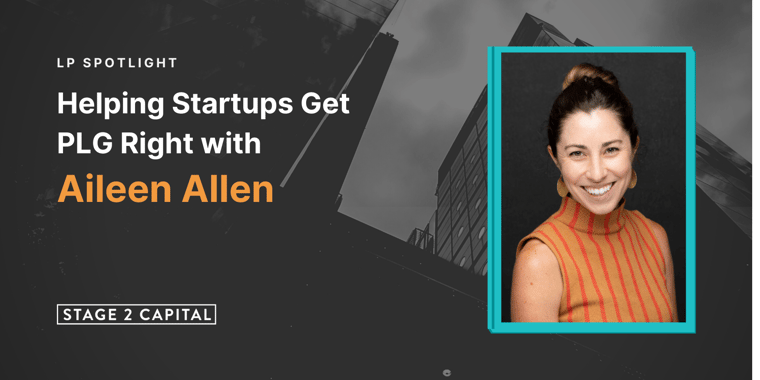As a Stage 2 Capital LP, Aileen Allen is known for her experience as a revenue-generating marketing leader with a deep interest in PLG motions. She has 15+ years of B2B software marketing experience, including leading functions of product marketing at Atlassian, and as VP, Marketing at Vanta and Gremlin. She is now working with multiple emerging companies as an advisor.
Aileen sat down with Stage 2 Capital Co-Founder & MD Mark Roberge to discuss her experience pioneering PLG at Atlassian, as well as what she’s seeing in today’s PLG plays.
How do you work with founders to determine if PLG is right for them?
"A lot of founders tend to think that they need to implement PLG, or self-serve, motions because it’s ‘the right thing to do’ or because ‘it’s the future’. I don’t know that we’ll ever be in a world where sales-assisted and high-touch motions will be obsolete, so I caution founders from rushing into something that isn’t right for their company, or the current state of their product.
If a product is too complex for users to find value from the product without a human intervention — onboarding setup, customer success managers, etc., then founders shouldn’t force the model into their GTM motion. The risk in doing so is brand damage — you only get one chance to make a first impression and if you’re throwing new users into a leaky funnel, or an onboarding flow that doesn’t optimize for immediate value, it’ll be very hard to win that user back when your product and customer journey is ready for them.
Take your time and experiment with ways to infuse low-touch experiences that drive product value. For example, if you launch a new feature, how are you pushing discovery of the feature and driving engagement with it? Or think about using PLG for expansion. You have users who are already familiar with your product, so exposing secondary products, or features in a higher tier plan, may be the best way for you to test into PLG vs starting with acquisition."
What did the Growth team look like at Atlassian, specifically in the early days?
"I joined Atlassian in 2013 and wasn’t ever part of the Growth team so I don’t want to speak too much out of turn here, but I’ll share my experiences in partnering with that department during the 7 years I was there. My first memories of Atlassian’s Growth team was as an experiential and embedded function of Product, where the primary goal was to convert free trial users into paid customers. These were engineers with a keen eye on experimentation.
Later, the Growth team stood on its own, and the team expanded scope to activation, end user engagement, conversion, and optimization across the entire product portfolio. This team was always in experimentation mode, and I loved seeing their readouts of successful and failed hypotheses. There’s a lot for us on the marketing side to learn from in terms of what’s resonating with users — we can surface that information earlier in the user journey to drive even more engaged usage once they’re in product. At some point Growth Product Marketing Managers emerged to drive user engagement and conversion at the top of the funnel (measured on activation), while Growth Product Managers were focused on subsequent engagement and often expansion (measured on D/MAU or paid users); these teams worked in close partnership with a centralized Growth team.
For anyone keen to learn more about the early days of Atlassian’s Growth function, I highly recommend this OpenView interview with Sean Clowes, former Head of Growth at Atlassian."
How should an early-stage PLG company think about pricing and packaging?
"When a founding team is assembling its product’s opening pricing and packaging for PLG, I recommend keeping things as simple and transparent as possible. It’s the company’s job to create a non-disruptive journey for customers — if packaging is too complex, and users are asking, ‘Which one is for us? Is there someone who can explain this to me?’, the self-service model starts to break down. Your goal is to get out of their way and push them into plans that make sense based on their current needs. Free trials are a great way to give users a preview of functionality without your team needing to think through feature and user gates in a freemium model.
I’ve seen companies rush into a freemium model, but what folks forget is that freemium is essentially a marketing exercise — you’re opening up the top of the funnel — but if your product, feature gates, and onboarding experience aren’t ready, I’d recommend waiting. Atlassian is synonymous with PLG, but we didn’t have a freemium plan for the first 17 years. I was part of the team that tried to launch free plans on multiple occasions, and it wasn’t until 2019 that we really felt confident in timing, readiness, and market opportunity.
In terms of price point, if someone is willing to swipe their own credit card, that’s what you’re aiming for. Pricing needs to be reasonable enough that it reflects product value, but not high enough that it requires multiple approval processes, or procurement teams to get involved. At that point, you’re in true enterprise territory."
What’s an example of a team that is working to operationalize PLG?
"Among other startups, one that I recently advised is an early-stage company that’s focused on creating and offering the easiest solution within their specific market, and using PLG to differentiate themselves (competitors run sales-assisted motions) and expand their reach.
In order to get there, they first needed to narrow down their ideal customer profile (ICP), and get the product into users’ hands as quickly as possible to refine their offering, and improve key pieces of PLG programs, like user onboarding. They’ve been spending a considerable amount of time collecting user research from short (~20 min) user interviews, as well as watching recordings of users interacting with the product. They’re learning where users are getting stuck, and temporarily making onboarding and activation a priority over net-new feature functionally — that’s a hard tradeoff to make but it’s the right one if you truly believe in the model. I have so much respect and admiration for their focus and dedication to launching with a successful PLG motion on day 1."

